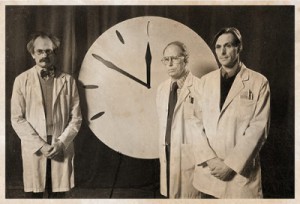
(from left to right, Full Stop Editors: J. Montgomery, A. Shubert, A. Shephard, M. Rivlin-Nadler, E. Jett, N. Knight)
First updated on July 7 in response to Adam Sandler’s film Jack and Jill, the Full Stop Doomsday Clock was instituted in order to “monitor and index our culture’s seemingly inexorable march toward barbarism.” The clock will be adjusted based upon momentous events at the discretion of the editors.
The Full Stop Doomsday clock now stands at 11:54PM due to recent announcements regarding the rise of robot journalism.
Following a recent New York Times article about computer generated journalism, the editorial staff at Full Stop has decided to a) advance by one minute the hand of the doomsday clock, and b) start freaking out. We hope the reader will note that we are not, by most standards, an alarmist publication. We have exhibited restraint in our stewardship of the Doomsday Clock, and more often than not, believe in the future of the printed word.
Every now and then, however, even the most Stoic are taken aback by the erosion of humankind’s sphere of influence and mastery over their creations. As the aforementioned article reports, at least 20 companies have begun utilizing a software that automatically generates reportage from raw data. The code is the culmination of a decade’s worth of research by Narrative Science Inc. (a clever anagram for the anti-humanist motto: Crania Evince Cretins) and has been described as a legitimate breakthrough in the field of computer generated writing. “I thought it was magic…It’s as if a human wrote it,” sez Roger Lee of Battery Ventures, according to the article.
Touted as a significant advance from earlier programs that produced rough, mad-lib-esque results, this new technology is raising plenty of questions and not a few red flags. Bracketing for a moment our own (well-founded!) fears, let’s consider the question that seems to be on everyone’s mind: “what effect will this have on flesh and blood human writers with beating hearts and pulses and all that?”
Little to none! sez Stuart Frankel, chief executive of Narrative Strategies (and anagram for Starker Flaunt, a cool name for a laser tag player). Frankel emphasized that the technology would primarily be used as a cost cutter for publications, allowing them to quickly generate cheap content that would otherwise be sacrificed. Galleycat reports that the company’s site provides the following list of easily generated types of content: sports stories, financial reports, real estate analyses, local community content, polling & elections, advertising campaign summaries sales & operations reports and market research. “Mostly, we’re doing things that are not being done otherwise,” Frankel told the Times.
So no big deal, right? No need for alarm? No way Jose!
A few things coming out of this story rub me the wrong way. First, there’s the incomplete list of companies using NS’s software. Trade publisher Hanley Wood and sports journalism providers The Big Ten Network have publicly admitted their complicity and cast their lot with the Machines, but what about the remaining, shadowy 18? Skynet, anyone? TMZ? Nasa.gov??? The possiblities are both endless and endlessly scary. Second, is that old Santayana paraphrase: Those who do not read speculative/alternative history are doomed to repeat it. The writing is on the wall, why don’t we read it?
And finally there is Kris Hammond’s statement that “in five years…a computer program will win a Pulitzer Prize — and I’ll be damned if it’s not our technology.” Though I doubt the immediate ascendency of the machine – consider the following front page blurb from the BTN.com: “So our new show “BTN Live” airs at 7 p.m. ET Thursday on BTN, and as you can tell from the name, it’s a live show from our BTN studios” – we must safeguard the few advantages we still have over robots, chief among which is our mastery of the written word and our ability to love. When we relinquish these, you won’t be damned, Mr. Hammond, we all will.
This post may contain affiliate links.








